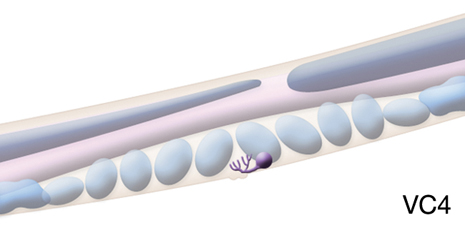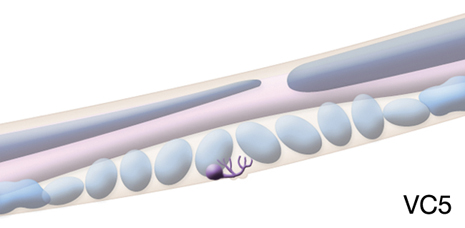|
VC1, VC2, VC3, VC4, VC5, VC6
Type: Motor neuron
In MoW: VCn
In Wormbase: VC1, VC2, VC3, VC4, VC5,
VC6
Lineage: P3.aap, P4.aap, P5.aap, P6.aap,
P7.aap, P8.aap
Location: Body (ventral nerve cord)
Description: Postembryonically born. Hermaphrodite specific ventral cord motor neurons. The neurons are born in L1, and begin to send out processes in late L3. These processes branch in the region of the vulva during L4. VC4 and VC5 have short ventral cord processes, but send branched processes dorsally along the vulval hypodermis on each side of the vulval slit. VC1-3 and VC6 send less branched processes to vulval regions but have longer processes in the ventral cord (in R side fascicle). The dorsal branches of VC axons innervate vm2 vulval muscles. These neurons, except VC4 and VC5, also innervate ventral body muscles.
The generation of VC neurons from the 6 Pn.a neuroblast lineages (P3.a-P8.a) is dependent on a HOM-C gene, lin-39. In the absence of lin-39, these neurons undergo programmed cell death (Ruvkun, 1997). The formation of the complex arborizations made by VC neuron branches at the level of the vulva depend on the presence of the vulval cells and the somatic gonad but not on the interactions of VC's with target muscles or HSN
|



|
neurons (Li and Chalfie, 1990; Colavita and Tessier-Lavigne, 2003) For a more detailed anatomical description of VC neurons also refer to Reproductive System-Egg-laying apparatus
Neurotransmitter/ Neuropeptide:
- Acetylcholine -after late L4. Not in VC4 and VC5
- Serotonin -only in VC4 and VC5 which likely take up serotonin released by HSNs
(Loer, 2010; Duerr et al, 2008; Duerr et al., 2001; Duerr et al., 1999; Rand and Nonet, 1997)
Innexin expression:
- UNC-7
- UNC-9
(Altun et al., 2009)
Receptor expression:
- ACR-14; expressed in VC54 and VC5; nicotinic AChR non-alpha subunit
- GLR-5 glutamate receptor subunit
(Fox et al., 2005; Brockie et al., 2001)
Function:
- Acetylcholine released from the VC neurons inhibits egg-laying behavior. This may be caused by inhibition of presynaptic neurotransmitter release by HSN neurons following the activation of the G-protein- coupled acetylcholine receptor 2 (GAR-2) signaling (Bany et al., 2003). VC4 and VC5 can also induce the active phase of egg-laying by releasing serotonin (Waggoner et al., 1998)
|
 Click pictures for higher resolution images Click pictures for higher resolution images

|

